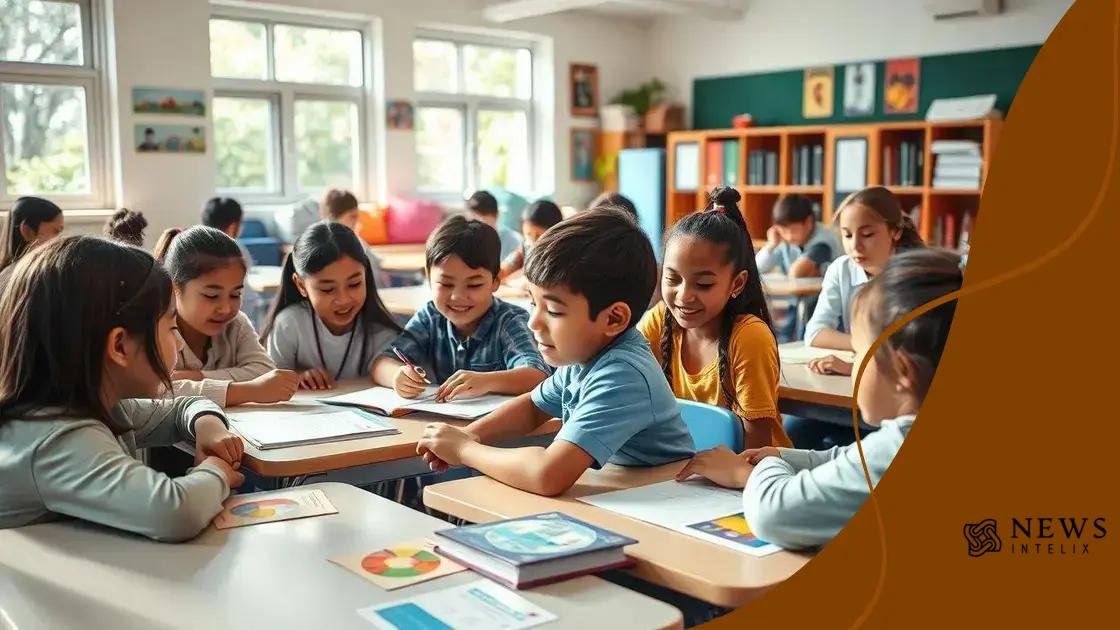Bilingual curriculums expand in urban schools

Bilingual curriculums expand in urban schools, providing significant benefits such as improved academic performance, enhanced cultural awareness, and better communication skills for students in diverse learning environments.
Bilingual curriculums expand in urban schools, offering students unique advantages in language acquisition and cultural literacy. But how do these programs influence education? Let’s take a closer look.
Understanding the need for bilingual education
Understanding bilingual education begins with recognizing its importance in today’s diverse society. As our world becomes more interconnected, students need skills that enable them to communicate across cultures.
The benefits of bilingual education
One significant advantage of bilingual curriculums is that they enhance cognitive abilities. Students who learn in two languages often develop better problem-solving skills and creativity. Additionally, being bilingual opens the door to various career opportunities in our globalized economy.
Key points to consider
- Enhanced cultural awareness: Bilingual education fosters understanding and respect for different cultures, which is vital in multicultural communities.
- Improved academic performance: Studies have shown that bilingual students often perform better in standardized tests.
- Strong community ties: Offering bilingual education can strengthen relationships between schools and local communities.
Furthermore, bilingual curriculums equip students with valuable skills for the future, allowing them to thrive in various environments. Schools adopting these programs are not just teaching languages; they are preparing students for a world where communication is key. For instance, schools that embrace this approach often see an increase in student engagement and participation. This creates an enriched learning environment where students feel valued and understood. It’s essential to understand that when students learn in their native languages alongside a second language, they are likely to perform better academically, showing a remarkable improvement in their overall educational experience. Overall, the benefits are clear: embracing bilingual education helps cultivate well-rounded individuals who are prepared for the challenges of the modern world.
Benefits of bilingual curriculums in urban schools
The benefits of bilingual curriculums in urban schools are numerous and profound. These programs not only enhance language skills but also promote a deeper cultural understanding among students.
Academic advantages
Research has shown that students in bilingual programs often outperform their peers in standardized tests. This improvement is linked to enhanced cognitive abilities gained through learning in multiple languages. Furthermore, bilingual education helps students develop critical thinking skills early on, which are essential for academic success.
Social and emotional growth
Beyond academics, a bilingual curriculum fosters a sense of belonging and community. Students learn to appreciate different cultural perspectives, which builds empathy and social skills. For instance, working collaboratively on group projects allows students to communicate and connect, creating friendships that span linguistic barriers.
- Increased job opportunities: Being bilingual opens many doors in the job market, providing an edge in competitive fields.
- Better communication skills: Bilingual students often develop strong communication abilities, benefiting them in all areas of life.
- Cultural pride: Engaging in bilingual learning can help students feel proud of their heritage, boosting self-esteem and identity.
Moreover, schools that implement bilingual curriculums often see improved attendance rates. Parents and guardians are more engaged and motivated to be part of a system that values diverse languages and cultures. As students thrive in such supportive environments, they become more active learners, eager to participate and share their experiences. The integration of bilingual education not only prepares students for global citizenship but also enriches the school community, making it a more inclusive space for everyone.
Challenges faced in implementing bilingual programs

Implementing bilingual programs in schools comes with several challenges that educators and administrators must navigate. Understanding these obstacles is crucial for creating effective educational experiences.
Resource allocation
One significant challenge is the need for proper resources. Many schools lack the funding to hire qualified bilingual teachers. Without adequate training, teachers may struggle to deliver lessons effectively. Schools must advocate for financial support to develop these programs fully.
Cultural considerations
Another challenge involves cultural differences. In urban areas, students often come from various backgrounds. Ensuring that a bilingual curriculum respects and incorporates these diverse cultures can be complex. Schools need to engage with families and communities to create a program that reflects their values and experiences.
- Communication barriers: Language differences can hinder effective communication between teachers and parents, making it difficult to build a supportive learning environment.
- Curriculum development: Designing a balanced curriculum that integrates both languages without compromising content is a daunting task.
- Student readiness: Not all students come with the same level of proficiency in their native language, which can lead to disparities in learning.
Additionally, the perception of bilingual education can pose challenges. Some parents and community members may not understand its benefits, leading to resistance. It’s essential for schools to provide information about the advantages of bilingualism and create an open dialogue with stakeholders. As educators strive to address these challenges, they can strengthen bilingual programs, making them more effective for all students. Developing partnerships with local organizations can help overcome some of these hurdles, providing additional support and resources to schools. When schools actively promote understanding and collaboration, they create a stronger foundation for successful bilingual education.
Successful examples from diverse cities
Exploring successful examples of bilingual programs from diverse cities reveals the effectiveness of these initiatives. Cities around the world have implemented bilingual education with great success, benefiting students and communities alike.
New York City
In New York City, several schools have adopted dual-language programs that immerse students in both English and Spanish. These programs have shown remarkable results, improving students’ overall academic performance. By learning in both languages, students develop stronger communication skills and cultural understanding.
Los Angeles
Los Angeles has also made strides in bilingual education, particularly in schools serving large Hispanic communities. The bilingual programs here focus on both English and Spanish, helping to bridge the gap for students who may struggle with English proficiency. This dual approach has led to increased engagement and retention rates among students.
- Chicago: In Chicago, schools with bilingual education programs have reported a decrease in dropout rates and an increase in college readiness.
- Miami: Miami’s programs emphasize Cuban and Haitian Creole alongside English, celebrating local cultures while enhancing language skills.
- Toronto: Toronto offers bilingual programs in English and French, preparing students for success in a bilingual nation.
These examples highlight the potential of bilingual curriculums to foster inclusivity and improve educational outcomes. When schools in diverse cities implement programs tailored to their communities, they create rich learning environments where all students can thrive. The positive impacts on student achievement demonstrate that investing in bilingual education is not just beneficial; it is essential for preparing future generations for a global society. Through collaboration and support, these cities continue to set a standard for effective bilingual education.
Future trends in bilingual education
Future trends in bilingual education are evolving rapidly as our world becomes more interconnected. Educators are increasingly recognizing the importance of preparing students for a global society. As a result, several key trends are emerging.
Technology integration
One major trend is the integration of technology in bilingual classrooms. Digital platforms and apps are being used to enhance language learning. For instance, students can access interactive language games that make learning fun and engaging. This approach not only reinforces language skills but also prepares students for a tech-driven world.
Focus on cultural competency
Another trend is a growing emphasis on cultural competency. Schools are not just teaching languages; they are also addressing the cultural aspects that come with them. Programs are being developed to help students understand and appreciate different cultural perspectives. This fosters a sense of community and belonging among diverse student populations.
- Personalized learning: Tailoring education to meet individual student needs is gaining momentum. Programs are becoming more flexible, allowing students to progress at their own pace.
- Collaborative learning: Group projects and peer learning are being emphasized to promote teamwork and communication skills among bilingual students.
- Policy support: Governments and educational organizations are increasingly supporting bilingual education through legislation and funding, recognizing its importance for future generations.
The future of bilingual education is bright, with these trends paving the way for more effective and inclusive programs. As schools adapt to the demands of a changing world, they will continue to find innovative ways to engage students in meaningful language learning experiences. By embracing these changes, educators can cultivate bilingual citizens who are not only linguistically skilled but also culturally aware, ready to thrive in a diverse society.
FAQ – Frequently Asked Questions about Bilingual Education
What are the main benefits of bilingual education?
Bilingual education improves academic performance, enhances cultural awareness, and develops essential communication skills.
What challenges do schools face in implementing bilingual programs?
Challenges include limited resources, the need for qualified teachers, and addressing diverse cultural backgrounds.
How can technology enhance bilingual education?
Technology can provide interactive learning tools, online resources, and language apps that make learning engaging and accessible.
What future trends can we expect in bilingual education?
Future trends include increased technology integration, a focus on cultural competency, and personalized learning approaches.
